New Recycling Technologies for Several Wastes : Creation of a Recycling Society
Outline of the Research
Waste problems are now becoming unavoidable social problems. The technology that reduces the wastes and recycles them is an inevitable key technology for sustainable development and creation of a recycling society.
We are studying new recycling technologies for several construction wastes, especially the application for ground materials. We are developing the highly-functional ground materials (for example, earthquake resistant ground materials).
Recent Research Topics
- (1) New Recycling Method for High Water-Content Mud : Fiber-Cement-Stabilized Soil Method
- (2) New Recycling Method for Dehydration Cake from Semiconductor Factories : Creation of highly-functional Ground Materials
- (3) New Recycling Method for Wasted Gypsum Boards : Application for Soil Improvement
- (4) New Recycling Method for Paper Sludge : Application for Soil Improvement
- (5) New Recycling Method for Dehydration Cake from Quarries : Creation of Sphere Aggregates
(1) New Recycling Method for High Water-Content Mud : Fiber-Cement-Stabilized Soil Method
It is very hard to recycle the construction sludge and water purification sludge directly because the water content of these sludge is extremely high. Therefore, they have been discarded in the final disposal sites. However, the remaining capacity of the final disposal sites is decreasing and is not enough. Furthermore, since the transporting cost of these sludge is expensive, they are often thrown away illegally on the way to the final disposal sites. In result, the recycling rate of the construction sludge is extremely low.
Therefore, we are carrying out the cooperative research with private company to increase the recycling rate of the construction sludge. Through the cooperative research, we have already developed a new recycling system for high water-content sludge by using paper debris(fragments of old newspaper) and powder polymer, named "Fiber-Cement-Stabilized Soil Method". As the modified soils, named "Fiber-Cement-Stabilized Soils"have several features, such as high failure strength, high failure strain, high durability for drying and wetting, high durability for freezing and thawing, this method has more than 200 actual achievements. Furthermore, it was confirmed by the recent study that the modified soil has high dynamic strength and high resistance for the earthquake. We are now trying to apply this system to the environmental conservation such as reinforcement of river banks.
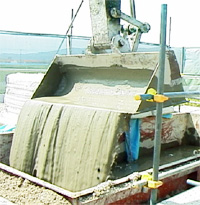
Construction sludge of 500% water content
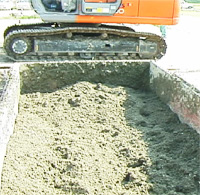
Fiber-Cement-Stabilized soil : We can walk on it just after the processing is over.
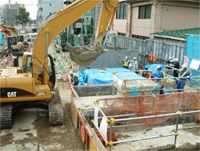
Construction site where Fiber-Cement-Stabilized Soil Method is carrying out (Sendai city, Japan)
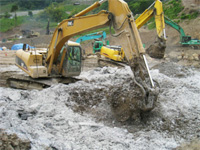
Fiber-Cement-Stabilized Soil Method at Tono dam construction (Tottori city, Japan)
(2) New Recycling Method for Dehydration Cake from Semiconductor Factories : Creation of highly-functional Ground Materials
A large amount of dehydration cake is discharged from semiconductor factories. However, as high concentration fluorine is generally contained in this dehydration cake, it is impossible to recycle the cake as ground materials. Aiming to utilize the dehydration cake as ground materials, we are studying to reduce the fluorine concentration to satisfy the environmental quality standard for soil by obtaining the fund of Miyagi Prefecture 3R New Technology Research Development Support. Furthermore, we are trying to use the wasted gypsum board paper instead of paper debris because recently the cost of paper debris is very expensive. As the wasted gypsum board paper is hardly recycled, if it can be used as a substitute for paper debris, it can be reduce the cost largely. In our experiment, wasted gypsum board paper was crushed by hammer mill and mixed with the mud. It was confirmed through the experiments that the crushed wasted gypsum board paper can be used as a substitute for paper debris. This research is also financially supported by the fund of Miyagi Prefecture 3R New Technology Research Development Support
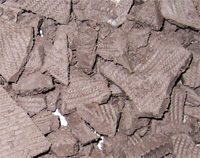
Dehydration cake discharged from semiconductor factory
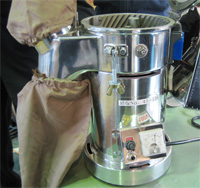
Hammer mill used in this experiment
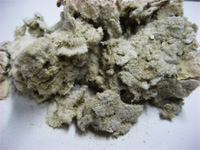
Crushed gypsum board paper by using hammer mill
(3) New Recycling Method for Wasted Gypsum Boards : Application for Soil Improvement
The amount of wasted gypsum board is increasing every year, but wasted gypsum board is one of the refractory materials and the recycling rate is extremely low. Furthermore, wasted gypsum board have to be disposed at the controlled-type final disposal sites and it costs much.
We are trying to apply wasted gypsum board for soil improvement. Specifically, first of all, we made a fiber contained semihydrate gypsum(CaSO4 1/2H2O) solidification material, and then we confirmed the solidification ability. Furthermore, specimens were made by using the developed solidification materials and were measured the failure strength and failure strain.
By the way, in the case that the gypsum is used for soil improvement, there is a fear that hydrogen sulfide generates. Therefore, in 2007, Takahashi laboratory carried out a cooperative research with Mori Institute for Environmental Technology to restrain the generation of hydrogen sulfide by obtaining the research fund from Yamagata Prefecture 3R Promotion Project. We have confirmed two effective methods to restrain the generation of hydrogen sulfide. The details of this project will soon be published in the journal.
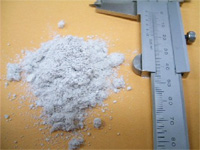
Fiber contained semihydrate gypsum(CaSO4 1/2H2O) solidification material
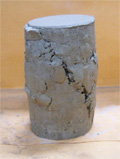
Specimen after unconfined compression test: Specimen was made by using fiber contained semihydrate gypsum(CaSO4 1/2H2O) solidification material.
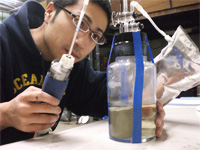
Experiments to restrain the generation of hydrogen sulfide
(4) New Recycling Method for Paper Sludge : Application for Soil Improvement
It was already confirmed that since the above-mentioned Fiber-Cement-Stabilized Soil contains the fiber materials inside, the failure strength and failure strain become large.
By the way, paper sludge discharged from paper recycling factory is incinerated or discarded at the final disposal sites. However, as the remaining capacity of the final disposal site is getting stringent, the recycling of paper sludge is strongly desired. Paper sludge contains short fiber materials, and it was already confirmed that the fiber materials play an important role for soil improvement. Therefore, if paper sludge can be used for soil improvement without burning it, this will contribute the increase of the recycling rate of paper sludge.
Therefore, we are developing a new material for soil improvement from paper sludge without burning it(PS material). We have already confirmed that Ps material is much more efficient for soil improvement than PS ash.
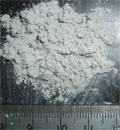
PS material made from paper sludge
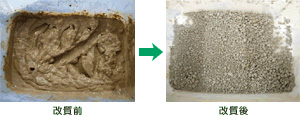
Left: High water content mud before improvement,
Right: Improved soil
(5) New Recycling Method for Dehydration Cake from Quarries : Creation of Sphere Aggregates
We are now studying a creation method of highly-functional sphere aggregates by using dehydration cake discharged from crushed rock quarries. Specifically, we are investigating the method to make a dehydration cake ball(sphere) and to melt and solidify it in the electric furnace with keeping the spherical shape. Furthermore, we are trying to make a light-weight highly-functional aggregate by adding some other waste materials such as fly ash and RC aggregates. The goal of this research is to make a new aggregate by using dehydration cake of high strength and lightweight.

Spherical aggregates made from dehydration cake
